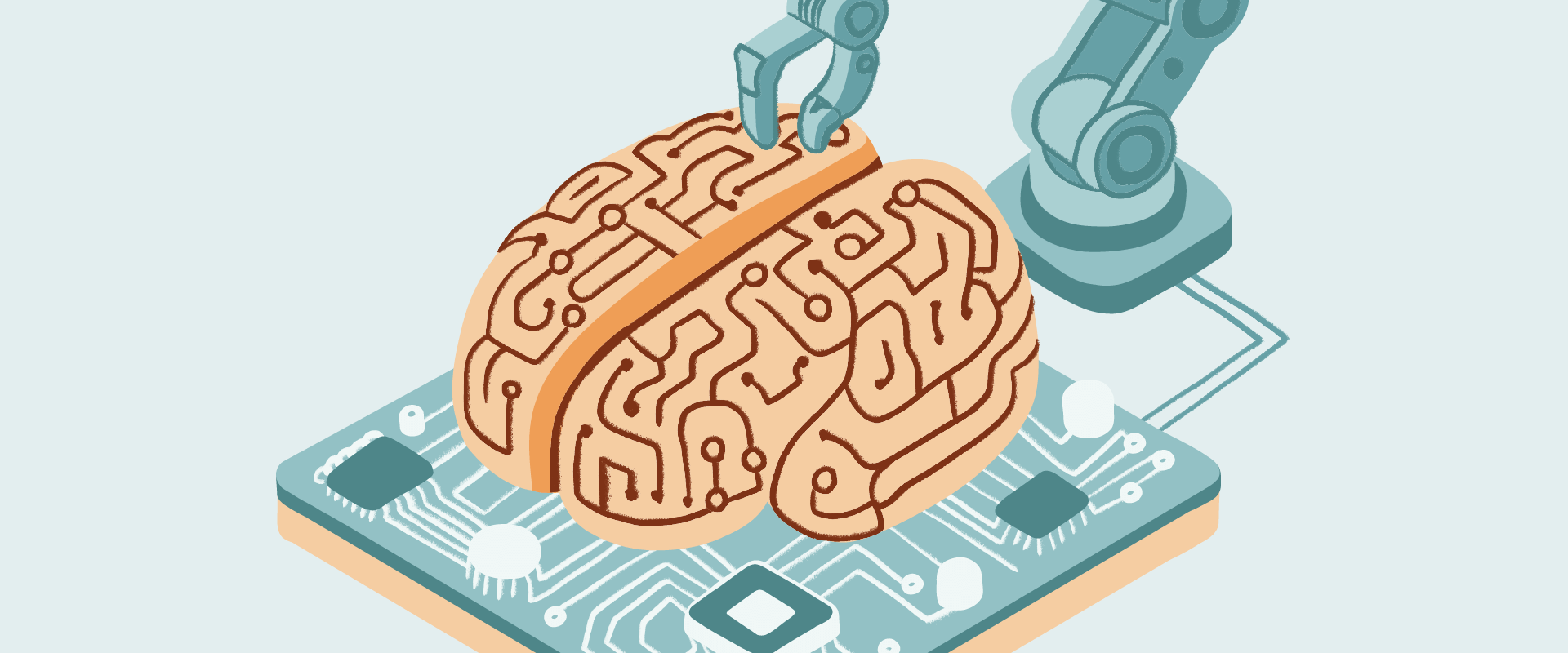Energy Healing Therapy: 7 Types That Support Mental Health and Addiction Recovery


Kayla holds over 6 years of experience in the rehab space, including in-house content management at a leading treatment center. She believes addiction and mental health issues are universal human experiences that can serve as important entry points onto a path toward self-realization and well-being.
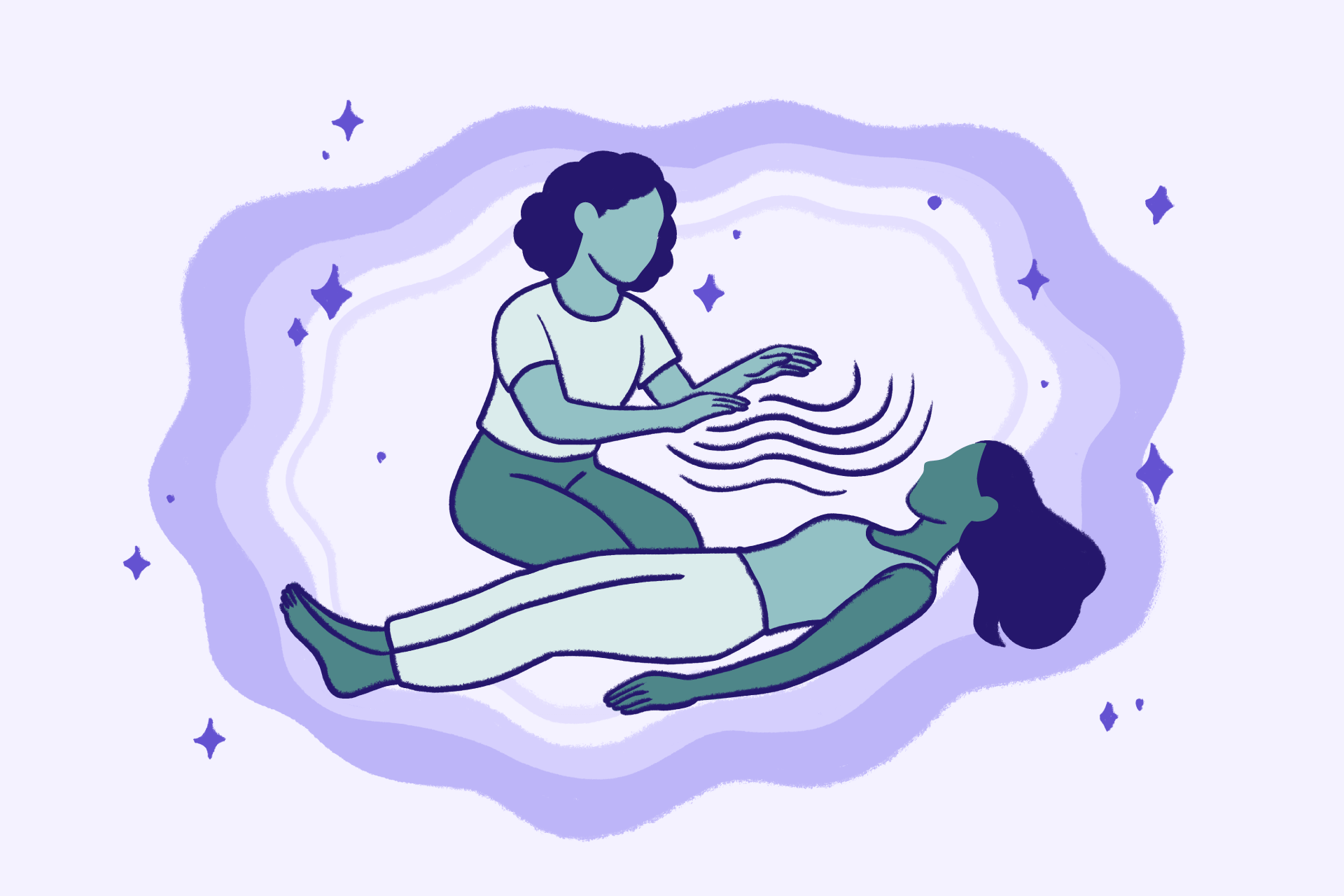


Kayla holds over 6 years of experience in the rehab space, including in-house content management at a leading treatment center. She believes addiction and mental health issues are universal human experiences that can serve as important entry points onto a path toward self-realization and well-being.
Table of Contents
- What is energy healing and how does it support mental health and addiction recovery?
- Understanding energy healing fundamentals
- 7 types of energy healing for mental health and recovery
- How energy healing supports specific recovery challenges
- Important note: finding reputable energy healers
- Building your personal practice
- FAQs
Have you ever wondered if there’s more to healing than just medication and conventional talk therapy? You’re not wrong. Many people in recovery from addiction or mental health challenges are exploring energy healing as a supportive practice alongside conventional healthcare.
Energy healing isn’t about replacing your medical care, it’s about enhancing it. These complementary therapies use the body’s natural energy systems to promote relaxation, reduce stress, and support your healing processes. From acupuncture sessions that ease anxiety to meditation practices that calm racing thoughts, energy healing offers gentle yet effective tools for your recovery journey.
We’ll explore 7 types of healing that have shown promise in supporting mental health and addiction recovery, help you understand how they work, and guide you toward making informed choices about incorporating them into your treatment plan.
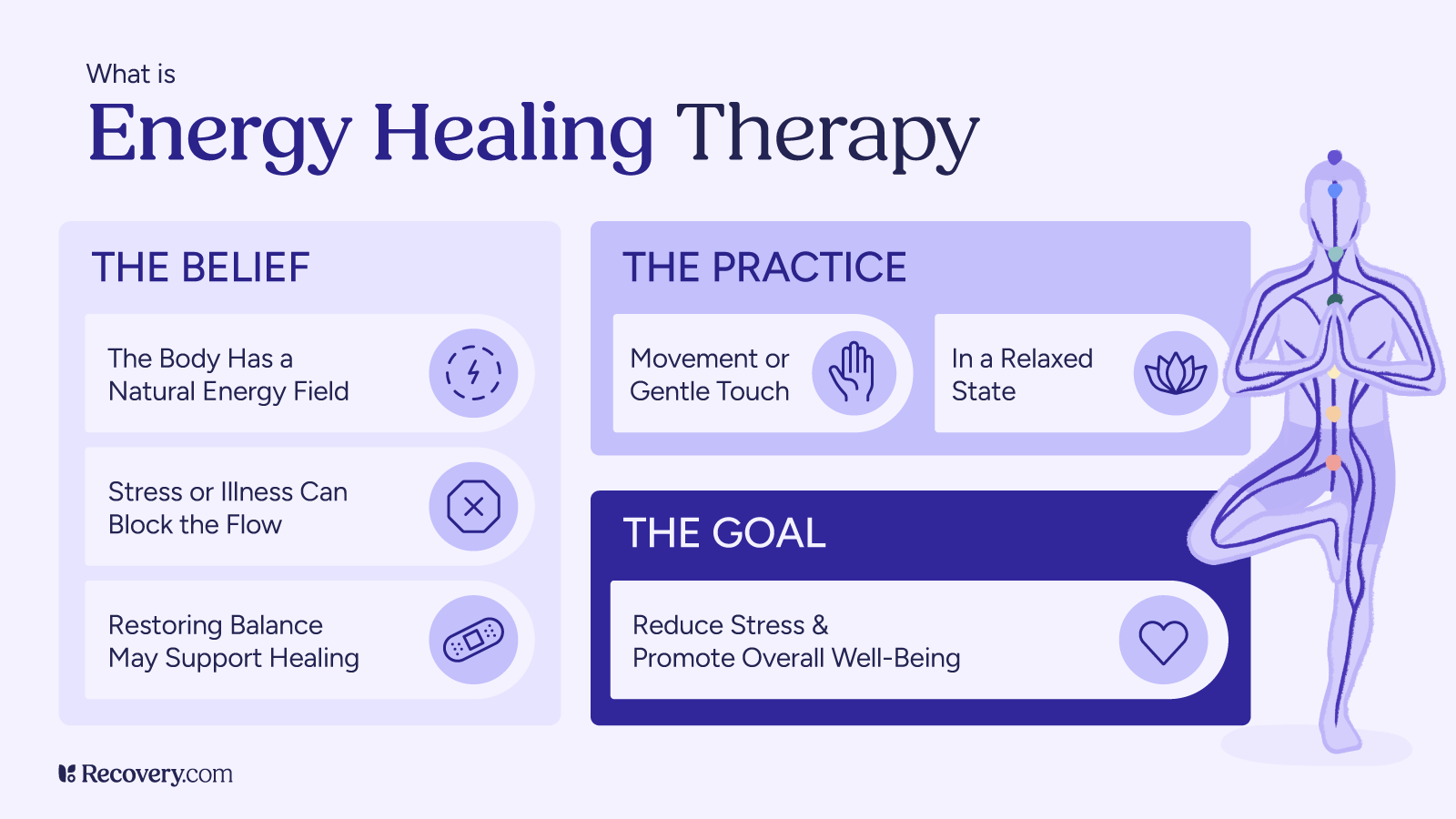
What is Energy Healing and How Does It Support Mental Health and Addiction Recovery?
Energy healing is based on the idea that your body has natural energy systems that, when balanced, promote physical and emotional wellness. These types of alternative medicine work with what many cultures call “life force energy”—known as Qi in Chinese medicine or prana in Indian traditions. When this energy flows freely, you feel more balanced, calm, and resilient.
Research shows that energy healing practices activate your body’s relaxation response,1 reducing stress hormones and promoting the release of feel-good chemicals like endorphins. For people in addiction recovery, this is especially valuable as it helps retrain the brain’s reward system naturally. Many people with substance use disorders have depleted dopamine and serotonin levels, and energy healing modalities can help restore this balance over time.
Learn more about rewiring your reward system in our article on dopamine and addiction.
In mental health treatment, energy healing addresses the mind-body connection that’s often disrupted by trauma, anxiety, and depression. For those in addiction recovery, it can ease withdrawal symptoms, reduce cravings, and teach healthy coping mechanisms. Energy healing works best as a complement to traditional medical care, not a replacement for it. Many treatment centers now incorporate these practices because they address the whole person—mind, body, and spirit.
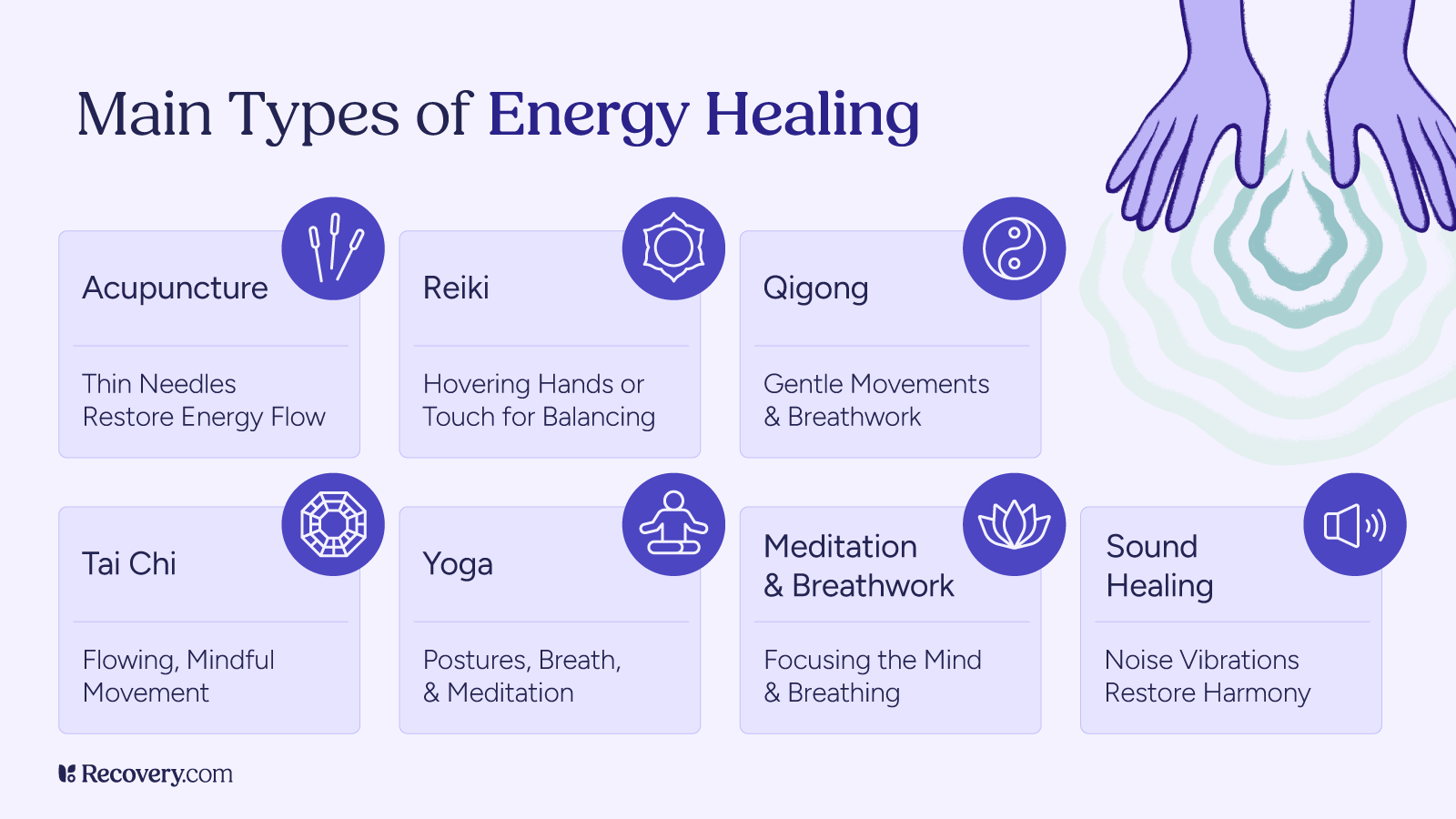
Understanding Energy Healing Fundamentals
Before exploring specific techniques, it’s helpful to understand the basic concepts behind energy healing. Most energy practices focus on balancing your body’s energy flow through specific pathways or centers. In Chinese medicine, these pathways are called meridians,2 while Indian traditions focus on energy centers called chakras.
Think of your energy system like a river. When the water flows freely, the ecosystem thrives. But when there are blockages or stagnation, problems arise. Energy healing aims to clear these blockages and restore healthy flow. This doesn’t require special beliefs—just an openness to exploring practices that have helped millions of people feel better.
Modern science is beginning to understand how these practices work. Studies show that energy healing affects the nervous system, reducing inflammation and promoting healing. Its measurable changes include decreased cortisol levels,3 improved heart rate variability, and increased production of healing hormones. These effects make energy healing valuable for people dealing with stress-related conditions, chronic pain, and the physical effects of addiction.
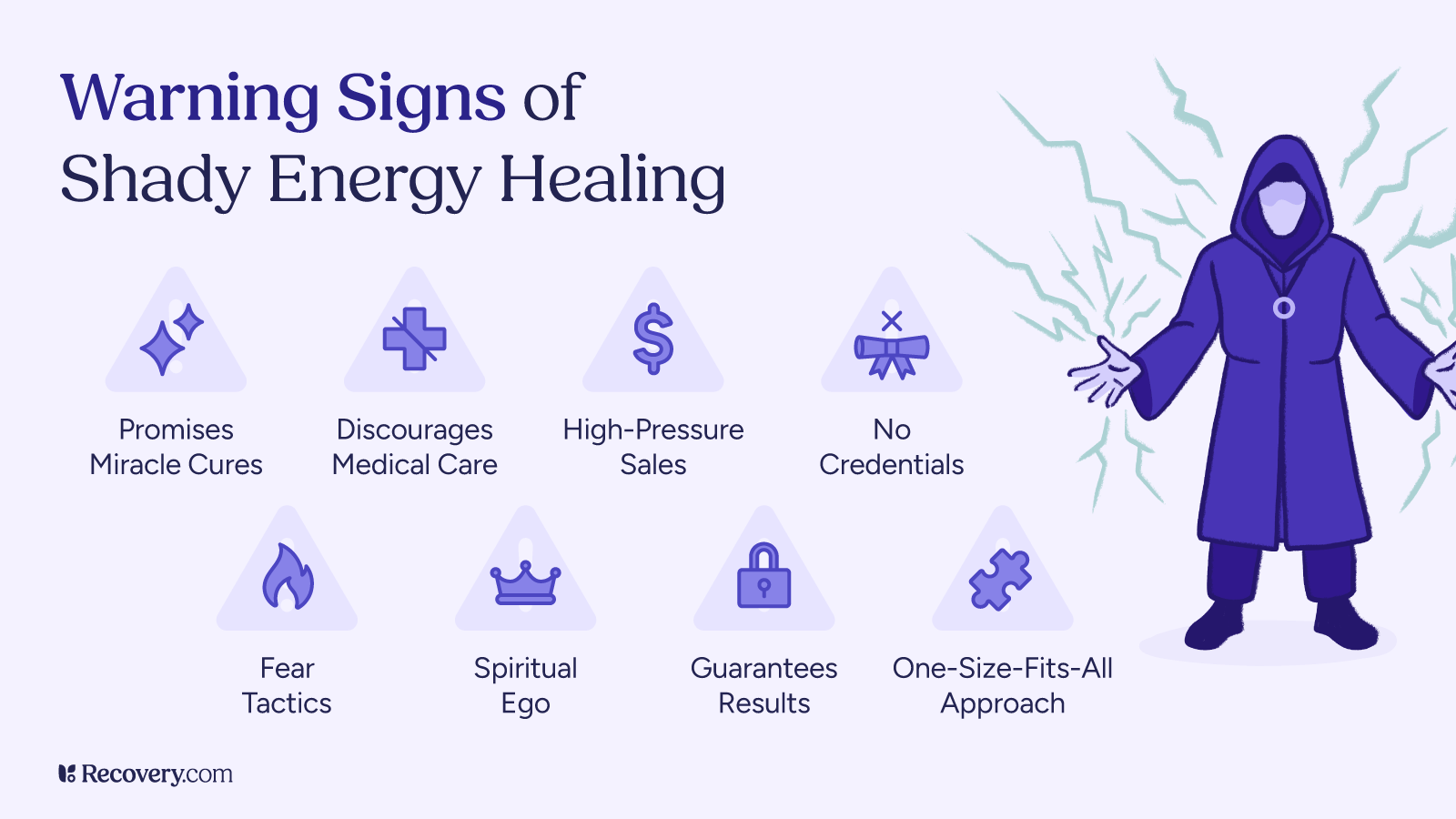
Explore Holistic Treatment Centers
7 Types of Energy Healing for Mental Health and Recovery
These diverse healing approaches tap into the body’s subtle energy systems, offering powerful support for emotional regulation, stress relief, and inner balance—especially when integrated into a comprehensive recovery plan.
1. Acupuncture: Precision Healing for Mind and Body
A core technique of traditional chinese Medicine (TCM), acupuncture involves inserting thin needles at specific points on your body to restore energy balance. Don’t worry—the needles are much thinner than those used for injections, and most people walk away from a session feeling relieved and relaxed.
Research shows acupuncture is effective for chronic pain,4 depression, and anxiety, among other conditions. For people in recovery, it’s shown to reduce cravings and ease withdrawal symptoms. The practice activates your body’s natural pain-relief system and releases endorphins, your body’s feel-good chemicals.
Many addiction treatment centers now offer acupuncture because it provides immediate relief from anxiety and restlessness. A typical session lasts 30–60 minutes, and you might feel deeply relaxed or even fall asleep during treatment. Most people notice improvements after several sessions, and it’s not uncommon to start feeling better right away.
2. Reiki: Healing Touch
Reiki is a Japanese practice where practitioners channel healing energy through their hands, either by light touch or hovering just above your body. This style of energy medicine focuses specifically on promoting balance and reducing stress. It’s usually performed by a Reiki master: someone with the certification level required to practice reiki on others.
Research shows that Reiki can help reduce anxiety,5 depression, and chronic pain. It activates your parasympathetic nervous system, otherwise known as “rest and digest” mode—the part responsible for rest and healing. For people in recovery, Reiki offers a safe, non-invasive way to experience therapeutic touch, which can be healing for those with trauma histories.
Note: If you’re uncomfortable with physical touch, you can request that your Reiki practitioner work with their hands hovering over your body instead, which still allows the energy transfer to take place.
The risks of Reiki are minimal since it’s non-invasive and doesn’t involve medications or equipment. Some people report feeling emotional during or after sessions as blocked energy is released. This is considered normal and often leads to a sense of lightness and peace afterward.
3. Qigong: Moving Meditation for Inner Peace
Qigong combines gentle movements, breathing techniques, and meditation to balance your body’s energy. Think of it as a slow, mindful form of exercise that anyone can do, regardless of fitness level.
This practice is excellent for reducing stress and improving overall well-being. Scientific evidence supports the use of Qigong for boosting immune function,6 lowering blood pressure, and improving sleep, among other benefits. For people with anxiety, the slow, controlled movements help break the cycle of racing thoughts and ground you in the present moment.
Regular Qigong practice can help you develop better emotional regulation7 and stress management skills. Many people find it easier to stick with than conventional workouts because it’s gentle and doesn’t require a gym membership or special equipment.
4. Tai Chi: Meditation in Motion
Tai chi takes elements from Qigong and adds martial arts-inspired movements. Often called “meditation in motion,” it helps build physical strength, balance, and mental clarity through flowing movements.
Research shows tai chi can reduce symptoms of depression and anxiety8 while improving physical health. It’s especially beneficial for older adults and people with chronic pain conditions. This practice helps you develop mindfulness skills while gently strengthening your body.
For people in early recovery, tai chi provides structure and routine while building confidence and community. Many classes have a social component, which helps combat isolation—a common challenge in recovery.
5. Yoga: Uniting Body, Mind, and Spirit
Yoga combines physical postures, breathing exercises, and meditation to optimize the flow of energy and address imbalances in your chakras. Chakras are energy centers in the human body that correspond to different aspects of physical and emotional health. When these centers are balanced, you feel more grounded and emotionally stable.
Different yoga styles offer different benefits. Gentle, restorative yoga eases anxiety and insomnia, while more active styles build strength and endurance. Studies show yogic breathing techniques (pranayama) can reduce anxiety9 associated with addiction and withdrawal.
Yoga addresses both the physical and emotional aspects of healing. It improves your self-awareness while teaching you to observe your thoughts and feelings without judgment—a hugely helpful skill for long-term recovery.
6. Meditation and Breathwork: Your Inner Healing Tools
Meditation is the practice of intentionally focusing your attention (often on the breath, a mantra, or bodily sensations) while observing your thoughts and feelings without judgment. Over time, this builds self-awareness, emotional regulation, and the ability to respond to stressors more wisely.
In addiction recovery, meditation is proven to reduce the risk of relapse10 by helping people recognize triggers and cravings without immediately acting on them. It also supports long-term mental health by reducing symptoms of depression and anxiety, improving sleep, and increasing overall emotional resilience. Regular practice—even just a few minutes a day—can noticeably shift how you relate to yourself and the world around you.
Breathwork is a powerful way to regulate your emotions and reconnect with your body, which can be very helpful during the ups and downs of recovery.
Try Box Breathing: A Simple Grounding Technique
Box breathing is a controlled breathing technique that can help regulate your nervous system in moments of stress. To try it:
- Inhale for 4 counts.
- Hold your breath for 4 counts.
- Exhale for 4 counts.
- Hold again for 4 counts.
Repeat this process, creating a steady, calming rhythm.
This practice activates the parasympathetic nervous system, which helps reduce anxiety, slow your heart rate, and bring your body back to a state of balance.
For people in addiction recovery, box breathing can be a simple and effective way to pause and ground themselves during cravings or high-stress situations. It’s quick, discreet, and accessible—making it easy to use anytime, anywhere.
7. Sound Healing: Vibrational Medicine
Sound healing therapy is based on the idea that everything vibrates at different frequencies, and certain sounds can help restore harmony to your energy field (also called the biofield). Sound healing might include instruments like singing bowls, gongs, or even specific frequencies played through speakers. Integrative health researchers John Beaulieu and David Perez-Martinez describe this therapy and its benefits:
Sound healing is the practice of using sound and listening in a mindful manner11 to transform and expand consciousness to enhance the body’s natural drive to regenerate and heal itself…Mindful listening, mantra repetition, and other meditative techniques facilitate the ability to quiet or silence the mind.
While research is still emerging, many people report feeling deeply relaxed and peaceful after sound healing sessions. Specially tuned vibrations can help release physical tension and emotional blockages.
Learn more about this gentle yet effective practice in our guide to sound healing for addiction and mental health recovery.
How Energy Healing Supports Specific Recovery Challenges
Energy healing can be helpful for common challenges in mental health and addiction recovery. For chronic pain, acupuncture12 and other alternative therapies show measurable benefits in reducing pain levels and improving quality of life. Many people with chronic pain also struggle with depression and anxiety, making energy healing an effective way to address these issues simultaneously.
Systematic reviews confirm that anxiety and stress respond well to most forms of energy healing.13 The combination of deep breathing, mindful movement, and deep relaxation can break the cycle of worry and physical tension that characterizes anxiety disorders. For people in recovery, this is especially important because stress is a major trigger for relapse.
Depression often involves feeling disconnected from your body and emotions. Energy healing practices help you reconnect with yourself in a gentle, nonjudgmental way. Physical movement in practices like yoga and tai chi also help transmute the lethargy and hopelessness that often accompany depression.
Important Note: Finding Reputable Energy Healers
Unfortunately, some people with predatory behaviors are attracted to healing professions because they provide access to vulnerable people. Nami Bates, an energy healer and hypnosis expert who specializes in helping women heal from toxic relationships, advises people in recovery to avoid red-flag “healers” who:
- Claim to be divine or the only person who can heal you
- Pressure you into romantic relationships
- Use spiritual excuses for disrespectful behavior
- Guarantee permanent cures
- Display spiritual ego by judging others for not being “enlightened enough”
- Project fear by predicting negative outcomes or disasters
- Insist on a “my way or the highway” approach, demanding you follow only their methods
Good healers listen more than they talk, respect your boundaries, offer clear pricing, and encourage you to maintain your primary care. They should be properly trained and certified in their practice. Always trust your instincts: If something feels off, it probably is. Check reviews and ask for referrals from trusted sources.
Building Your Personal Practice
You don’t need to wait for professional sessions to benefit from energy healing. Simple daily practices can make a big difference in your well-being. Start with just 10-15 minutes of meditation or gentle stretching each morning. You can easily do a simple technique like box breathing, for example, any time you feel stressed or triggered.
Many online resources offer guided practices you can do at home. Start small and be consistent instead of trying to do everything at once. As part of a transformative recovery process, you might choose to work with qualified practitioners who can guide you through deeper healing work.
Remember that healing is a journey, not a destination. Be patient with yourself and notice your progress. Energy healing works best when combined with other healthy self-care practices like regular sleep, good nutrition, and connection with supportive people.
Start Exploring Energy Healing to Support Your Recovery
Energy healing offers gentle yet profound ways to support your mental health in recovery. From the precise meridian work of acupuncture to the flowing movements of tai chi, these practices are designed to address the whole person—mind, body, and spirit. While they’re not a replacement for conventional medical care, they can be just as important for enhancing your treatment process and quality of life.
The beauty of energy healing is its accessibility. These practices meet you where you are and work with your body’s natural healing abilities. Whether you’re dealing with chronic pain, anxiety, depression, or the challenges of addiction, energy healing can provide additional tools for your long-term recovery toolkit.
Ready to explore how energy healing can support your recovery? Our treatment finder can help you find facilities that incorporate these holistic approaches into their programs. Reach out to a center to learn more about their program and take the next step in your healing journey today.
FAQs
Q: What are the 5 elements in energy healing?
A: The 5 elements typically refer to earth, water, fire, air (or wood), and space (or metal) in various traditional healing systems. These elements represent different qualities of energy and are used to understand balance in the body and mind.
Q: What are some other energy healing techniques?
A: Beyond the 7 covered in this article, other techniques include reflexology, craniosacral therapy, energy psychology methods like EFT (tapping), aromatherapy, and various forms of bodywork like massage therapy.
Q: Can I practice energy healing on myself?
A: Many energy healing techniques can be self-practiced, including meditation, breathwork, gentle yoga, and basic Qigong. However, some hands-on practices like acupuncture and Reiki require trained practitioners.
Q: How do I know if energy healing is working?
A: You might notice increased relaxation, better sleep, reduced anxiety, improved mood, or decreased pain. Some people feel energized while others feel calm. Effects can be immediate or build gradually over time.
Q: Are there any side effects to energy healing?
A: Energy healing is generally very safe. Some people experience temporary emotional release, mild soreness from movement practices, or feeling tired after sessions as the body processes and integrates the healing.
-
Mayer, M. (2009). Energy psychology: Self-healing practices for bodymind health. North Atlantic Books.
-
Ciulla-Bohling, R. (2024). Meridian (Chinese medicine). EBSCOhost Research Starters. EBSCO Information Services.
-
Díaz-Rodríguez, L., Arroyo-Morales, M., Fernández-de-las-Peñas, C., García-Lafuente, F., García-Royo, C., & Tomás-Rojas, I. (2011). Immediate effects of reiki on heart rate variability, cortisol levels, and body temperature in health care professionals with burnout. Biological research for nursing, 13(4), 376–382. https://doi.org/10.1177/1099800410389166
-
Yan, B., Zhu, S., Wang, Y., Da, G., & Tian, G. (2020). Effect of acupuncture on chronic pain with depression: A systematic review. Evidence-Based Complementary and Alternative Medicine, 2020, Article 7479459. https://doi.org/10.1155/2020/7479459
-
Thrane, S., & Cohen, S. M. (2014). Effect of Reiki therapy on pain and anxiety in adults: an in-depth literature review of randomized trials with effect size calculations. Pain management nursing : official journal of the American Society of Pain Management Nurses, 15(4), 897–908. https://doi.org/10.1016/j.pmn.2013.07.008
-
Oh, B., Bae, K., Lamoury, G., Eade, T., Boyle, F., Corless, B., Clarke, S., Yeung, A., Rosenthal, D., Schapira, L., & Back, M. (2020). The effects of Tai Chi and Qigong on immune responses: A systematic review and meta-analysis. Medicines, 7(7), 39. https://doi.org/10.3390/medicines7070039
-
Yeung, A., Chan, J. S. M., Cheung, J. C., & Zou, L. (2018). Qigong and Tai-Chi for mood regulation. Focus, 16(1), 40–47. https://doi.org/10.1176/appi.focus.20170042
-
Wang, F., Lee, E.-K. O., Wu, T., Benson, H., Fricchione, G., Wang, W., & Yeung, A. S. (2014). The effects of Tai Chi on depression, anxiety, and psychological well-being: A systematic review and meta-analysis. International Journal of Behavioral Medicine, 21(4), 605–617. https://doi.org/10.1007/s12529-013-9351-9
-
Muniyandi, S. (2015). Effectiveness of pranayama on anxiety among alcoholics in a selected de-addiction centre at Chennai. International Journal of Nursing Education and Research, 3(3), 299–309. https://doi.org/10.5958/2454-2660.2015.00012.5
-
Priddy, S. E., Howard, M. O., Hanley, A. W., Riquino, M. R., Friberg-Felsted, K., & Garland, E. L. (2018). Mindfulness meditation in the treatment of substance use disorders and preventing future relapse: Neurocognitive mechanisms and clinical implications. Substance Abuse and Rehabilitation, 9, 103–114. https://doi.org/10.2147/SAR.S145201
-
Beaulieu, J., & Perez-Martinez, D. (2018). Sound healing, theory, and practice. In Nutrition and integrative medicine (1st ed., p. 21). CRC Press. https://doi.org/10.4324/9781315153155
-
Vickers, A. J., Cronin, A. M., Maschino, A. C., et al. (2012). Acupuncture for chronic pain: Individual patient data meta-analysis. JAMA Internal Medicine, 172(19), 1444–1453. https://doi.org/10.1001/archinternmed.2012.3654
-
Shore, A. L. G. (2002). The long-term effects of energetic healing on symptoms of psychological depression and self-perceived stress (Publication No. 3047964) [Doctoral dissertation, Institute of Transpersonal Psychology]. ProQuest Dissertations & Theses Global.
Our Promise
How Is Recovery.com Different?
We believe everyone deserves access to accurate, unbiased information about mental health and recovery. That’s why we have a comprehensive set of treatment providers and don't charge for inclusion. Any center that meets our criteria can list for free. We do not and have never accepted fees for referring someone to a particular center. Providers who advertise with us must be verified by our Research Team and we clearly mark their status as advertisers.
Our goal is to help you choose the best path for your recovery. That begins with information you can trust.








